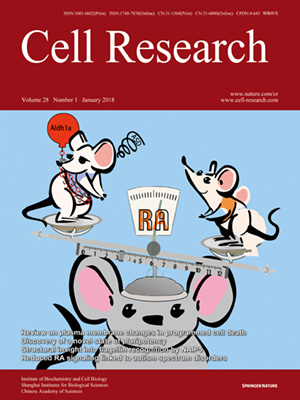
Volume 28, No 1, Jan 2018
ISSN: 1001-0602
EISSN: 1748-7838 2018
impact factor 17.848*
(Clarivate Analytics, 2019)
Volume 28 Issue 1, January 2018: 126-129 | Open Access
LETTERS TO THE EDITOR
Human embryonic stem cells contribute to embryonic and extraembryonic lineages in mouse embryos upon inhibition of apoptosis
Xuepeng Wang1,2,*, Tianda Li1,*, Tongtong Cui1,2,*, Dawei Yu1,*, Chao Liu1,2,*, Liyuan Jiang1,3, Guihai Feng1, Lei Wang1,2, Rui Fu1, Xinxin Zhang1,3, Jie Hao1, Yukai Wang1, Liu Wang1,2, Qi Zhou1,2, Wei Li1,2 and Baoyang Hu1,2
1State Key Laboratory of Stem Cell and Reproductive Biology, Institute of Zoology, Chinese Academy of Sciences, Beijing 100101, China;
2University of Chinese Academy of Sciences, Beijing 100049, China;
3College of Life Science, Northeast Agricultural University of China, Harbin 150030, China.
Correspondence: Baoyang Hu, E-mail: byhu@ioz.ac.cn;; Wei Li, E-mail: liwei@ioz.ac.cn;; Qi Zhou,(qzhou@ioz.ac.cn)
Recently, interspecies chimera formation has been established in rodents by injection of rat pluripotent stem cells (PSCs) into mouse early embryos, and such a system provides an in vivo assay to test the developmental potential of human PSCs (hPSCs)1. In addition, the interspecies chimeras formed between hPSCs and large animal embryos would open new avenues to generate human tissues and organs for regenerative medicine2. In rodents, embryonic stem cells (ESCs) and epiblast stem cells (EpiSCs) have been derived from inner cell mass (ICM) of the blastocyst and post-implantation epiblast respectively3,4. Although both being pluripotent, the ESCs and EpiSCs are considered to represent two distinct states of pluripotency, the naïve and primed pluripotent state. Only naïve state ESCs can colonize the early embryos before the blastocyst stage to form adult chimeras and transmit to the germline, while the primed state EpiSCs can only integrate into the post-implantation embryos5,6. Intriguingly, although derived from the ICM, the human ESCs (hESCs) are similar to the mouse EpiSCs in many aspects such as the morphology and self-renewal pathways, hence they are considered to represent the primed pluripotent state. Several studies have reported the generation of human-animal interspecies chimeras using the stage-matching hESCs. For example, primed hPSCs were engrafted into in vitro cultured gastrula-stage mouse embryos to form chimeras, and the primed hPSCs were also converted into a naïve-like state and then were injected into pre-implantation embryos to form mouse or pig chimeras7,8,9.
10.1038/cr.2017.138
FULL TEXT | PDF
Browse 1668


